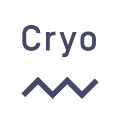Here we present real-time permafrost temperature data from operational monitoring sites in Svalbard and Norway. The most recent permafrost temperatures are compared to the climatology generated from the station's data record, providing median, confidence intervals, extremes and trends. There are also operational weather stations with extended measurement programs at several of these locations. The combined monitoring provides daily updated data for studying and monitoring the current state, trends and the effects of e.g. extreme climate events on permafrost temperatures. The operational monitoring provides information more quickly than ever before, potentially assisting in the early detection of e.g. record-high active layer thickness, pronounced permafrost temperature increases, and in early warning systems for natural hazards associated with permafrost warming and degradation. Currently, data and metadata are submitted manually to the international Global Terrestrial Network for Permafrost. Work is in progress to develop operational permafrost data services through the WMO Global Telecommunication System to support e.g. the WMO Global Cryosphere Watch datastream.
Background
Permafrost, or permanently frozen ground, is made up of soil or rock including ice and organic material that has remained at or below 0 °C for at least two consecutive years. In Norway, permafrost is widespread in the higher mountains. In northern Norway, some of the permafrost is located in mires, often producing palsas and peat plateaus. Measurements show that the permafrost in Norway is "warm", ranging typically between -3 and 0 °C.
Systematic long-term monitoring of permafrost in Svalbard and Norway essentially began in 1998 under the European Union-funded Permafrost and Climate in Europe (PACE) project, with the installation of ground temperature measurements in deep boreholes. More than 35 additional instrumented boreholes have been established in Norway and Svalbard since then. A shallow borehole monitoring network was established at Snøheim (Dovrefjell) in southern Norway in 2001. During the International Polar Year (2007-2009), monitoring networks were also built up in northern Norway, along with Svalbard. In recent years, new permafrost boreholes have been established at remote locations on Svalbard as part of the Svalbard Integrated Arctic Earth Observing System (SIOS, https://sios-svalbard.org/) and Climate-ecological Observatory for Arctic Tundra (COAT, https://www.coat.no/en/) projects.

Location of the real-time permafrost monitoring sites in Norway. In the background, a permafrost map for Norway, Sweden and Finland is shown providing a detailed and updated description of permafrost distribution in this area (after Gisnås et al. 2016).

The sites are run in co-operation with the University of Oslo, the University Centre in Svalbard, the Norwegian Polar Institute, and the Norwegian University of Science and Technology. In Svalbard, the sites except for Janssonhaugen, were established as part of the Svalbard Integrated Arctic Earth Observing System (SIOS, https://sios-svalbard.org/) and Climate-ecological Observatory for Arctic Tundra (COAT, https://www.coat.no/en/) projects. Part of the work related to the development of new permafrost products was supported by the Arctic Monitoring and Assessment Programme (AMAP). More information in Isaksen et al. (2022).

